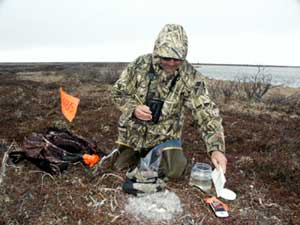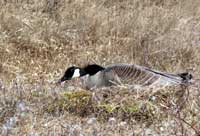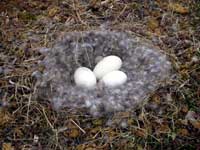Sympatrically Nesting Canada Geese and Lesser Snow Geese
Long-term monitoring (>25 years) of breeding Eastern Prairie Population (EPP) Canada geese (Branta canadensis interior) at Cape Churchill has documented a decline in nest density. Walter (1999) identified nest depredation, particularly by arctic fox (Alopex lagopus), as the most consistent factor affecting EPP reproductive success and subsequent recruitment over 20 years (1976 – 1996). Currently, there is concern about the influence of increasing nesting light goose populations (lesser snow goose [Chen caerulescens caerulescens] and Ross’s goose [Chen rossii]) on breeding Canada geese and the potential interacting effects of predators and light goose abundance on Canada goose population dynamics in northern Manitoba.
Nesting lesser snow geese have expanded their distribution considerably during the last 20 years moving into areas where they did not previously occur, and that were traditionally used solely by nesting EPP Canada geese (Walter 1999, Nack and Andersen 2004). The detrimental impact that large populations of snow geese have on sub-arctic vegetation communities is well documented. Considerably less information exists on the direct or indirect effects of this growing population on other species, particularly sympatrically nesting Canada geese. On Akimski Island in southern James Bay, Canada goose reproductive performance was reduced in the presence of sympatrically nesting lesser snow geese compared with when snow and Canada geese nested allopatrically (Gleason et al. 2004), yet the mechanisms contributing to the observed difference are not clear. Large groups of snow geese may alter local predator-prey dynamics (Walter 1999), potentially influencing nest depredation of Canada geese. However, how dense nesting aggregations of lesser snow geese affect nest depredation on sympatrically nesting species is not known.
In 2004, we initiated a research project to address the following questions:
- How do nesting aggregations of lesser snow geese affect the probability of depredation of sympatric EPP Canada goose nests at 2 sites with different histories of snow goose nest presence?
- How are sympatrically nesting Canada and snow geese arranged spatially relative to each other?
- How are nesting EPP Canada geese distributed across their range, what changes have occurred in this distribution between 1980 and 2006, and what factors influence the observed distribution?
Gleason, J.S., K.F. Abraham, C.D. Ankney, and J.O. Leafloor. 2004. Variation in reproductive performance of Canada geese in the presence and absence of lesser-snow geese. Pages 75-83 in T.J. Moser, R.D. Lien, K.C. VerCauteren, K.F. Abraham, D.E. Andersen, J.G. Bruggink, J.M. Colucey, D.A. Graber, J.O. Leafloor, D.R. Luukkonen, and R.R. Trost, editors. Proceedings of the 2003 International Canada Goose Symposium. Madison, WI.
Walter, S.E. 1999. Nesting ecology of eastern prairie population Canada geese. Dissertation, University of Wisconsin, Madison, Wisconsin, 204pp.
Publications
- 2004 EPP Research Report (.pdf)
- 2005 EPP Research Report (.pdf)


